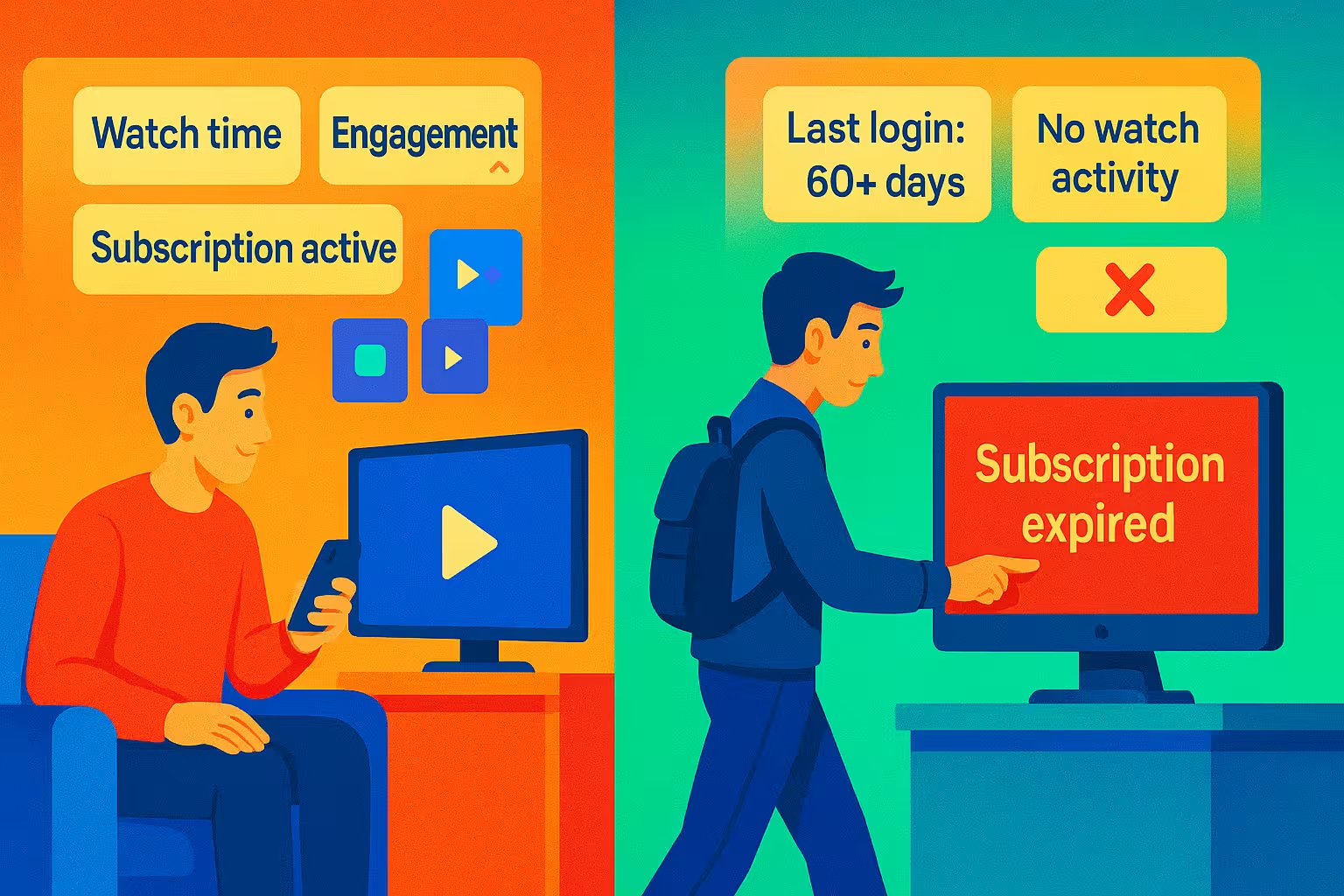
Understanding OTT Churn Rate and Annual Subscriptions for Streaming Services
The OTT industry is rapidly evolving, with fierce competition and constantly changing consumer preferences. As a result, combating subscriber churn remains a top priority for service providers looking to maintain steady growth across both short‑term and long‑term timeframes.
One of the most promising strategies emerging in recent years involves implementing long-term annual subscription models. By analyzing subscriber metrics, platforms can better understand retention patterns and optimize their offerings.
This article explores the causes of OTT churn, the potential benefits of long-term subscriptions, and effective strategies for reducing churn.
What is OTT Churn?

OTT churn refers to the rate at which users discontinue their subscriptions to over-the-top (OTT) services. With an ever-increasing number of streaming platforms competing for attention, users frequently switch services based on content availability, pricing, and user experience. Poor navigation, content gaps, or frequent app crashes can severely impact user satisfaction.
According to Parks Associates, the global churn rate for OTT services reached an all-time high of 50% by Q3 2023, marking one of the biggest OTT churn periods in recent history and highlighting the urgent need for retention strategies.
How to Calculate OTT Churn Rate and Retention Metrics
Churn Rate = (Users at Start of Period – Users at End of Period) / Users at Start of Period
Choosing the correct measurement period is critical. For example, monthly churn can hide deeper trends only visible quarterly or annually.
Customer Retention Rate (CRR) = [(Users at End of Period – New Users Gained) / Users at Start of Period] x 100
CRR provides a complementary view to churn, reflecting how well the platform retains existing customers.
Voluntary vs. Involuntary Churn:
- Voluntary: User cancels intentionally (e.g., due to price or lack of interest).
- Involuntary: Subscription fails due to payment issues or expired cards.
Benchmarks:
An OTT churn rate above 5% is typically a red flag. Leading services strive for monthly churn below 3%.
Industry Benchmarks for OTT Churn Metrics
- The Netflix churn rate is among the lowest in the industry at approximately 2.4% monthly, reflecting its strong content library and global appeal across ~270M subscribers.
- Disney+ follows with a ~4.3% monthly churn rate and ~150M subscribers.
- Hulu reports a ~5% monthly churn rate with around 50M subscribers.
Smaller platforms often face a higher customer churn rate due to limited exclusive content or weaker UI/UX.
Common Causes of OTT Subscription Churn

Understanding why subscribers leave is crucial for developing effective retention strategies. Some of the most prevalent causes include:
- Pricing Discrepancies and Competitive Pressure: When users perceive the cost of a subscription as too high or encounter better offers from competitors, they often choose to cancel their service.
- Content Availability and Freshness: A stagnant or outdated content library can lead to user frustration and eventual cancellation.
- Technical Challenges and Poor User Experience: Problems such as streaming interruptions, buffering, outdated interfaces, or complicated navigation can drive users away.
- Lack of Personalization: Failing to provide tailored recommendations or curated experiences can diminish user engagement and highlights the need for effective content personalization strategies.
- Subscription Renewals and Payment Problems: Issues such as expired cards, failed transactions, or unclear subscription renewal processes contribute to involuntary churn.
- Device Limitations and Accessibility Barriers: Users expect services to be available across multiple devices seamlessly. Any restrictions or poor compatibility can result in churn.
- Overwhelming Advertising or Upselling: Excessive promotional messages or frequent upsell attempts can negatively impact the user experience, leading to dissatisfaction.
- Content Overload and Discovery Fatigue: With so much content available, users often feel overwhelmed. Discovery fatigue leads to frustration and cancellations when they can't find content easily.
- Subscription Fatigue and Cross-Category Competition: Consumers juggle multiple subscriptions across entertainment, fitness, education, and even short-form social media. OTT services now compete not just with other platforms, but also with TikTok, YouTube Shorts, and Instagram Reels.
- Ease of Cancellation Paradox: While ease of cancellation is user-friendly (and legally mandated in many regions), it accelerates OTT churn. In fact, 84% of users say canceling easily is a major draw, but it makes it equally easy to walk away.
The Shift Toward Long-Term Annual Subscriptions

OTT platforms are increasingly turning to long-term subscription plans as a means to combat churn. By offering extended commitments, service providers aim to enhance customer loyalty, improve revenue forecasting, and foster a deeper commitment from their audience. As highlighted in UniqCast’s The Ultimate Guide to OTT Technology 2025, long-term subscriptions are becoming a favored strategy to reduce churn and ensure sustained growth.
Benefits and Considerations

Implementing long-term subscription models offers several advantages for growing and stabilizing your subscriber base:
- Enhanced Customer Retention: Subscribers committed to longer terms are less likely to cancel, leading to improved retention performance and stronger viewer retention through consistent content engagement.
- Improved Revenue Forecasting: Extended commitments allow for more accurate financial planning and resource allocation.
- Increased Customer Lifetime Value: Long-term subscribers contribute more significantly over time compared to short-term users.
However, it's crucial for OTT providers to balance these offerings with flexibility. The rise of the subscription pauser, users who temporarily suspend their subscriptions rather than opting for subscription cancellation the demand for adaptable subscription options. Streaming services are responding by introducing features that allow users to pause and resume their subscriptions with ease.
Comparing Monthly vs. Annual Subscription Models
Choosing between monthly and annual subscription plans is a critical decision for any business, impacting everything from customer acquisition and revenue predictability to cash flow and long-term investment strategies. Both models offer distinct advantages and disadvantages, and understanding these nuances is key to optimizing your subscription offerings.
Here are the pros and cons of each plan:
Monthly Plans
- Pros: Faster customer acquisition, flexibility, wider appeal
- Cons: Higher churn, unpredictable revenue, and more frequent subscription costs for users, which may deter long-term commitment
- Benefit: Lucrative over time with strong retention
Annual Plans
- Pros: Predictable revenue, fewer cancellations, better cash flow
- Cons: Higher CAC, longer sales cycles, potential payment disputes that may require a more robust billing service to manage effectively
- Business upside: Enables reinvestment into content and infrastructure while lowering the perceived subscription costs over time for committed users
Not all monthly churn signifies a lost annual opportunity. Many customers who churn on a monthly basis may not have been inclined to commit to an annual subscription in the first place or may prefer more flexible renewals that suit their short-term needs.
It is beneficial to frame pricing plans with a customer-centric approach, aligning offerings with user intent. By analyzing OTT subscriber metrics, platforms can identify distinct user segments such as short-term users who value flexibility and power users who prioritize long-term value ultimately contributing to both customer satisfaction and overall profitability.
Flexible and Value-Based Pricing Models
To convert more users to long-term plans, OTTs are adopting diversified strategies such as:
Tiered Pricing
Offer various subscription levels like Basic, Premium, and Family plans. This allows you to cater to different customer segments with varying needs and budgets, providing flexibility and encouraging upgrades as user engagement grows.
Freemium and Pay-Per-View
Provide entry-level access through a freemium model or pay-per-view options. This strategy helps build trust and familiarity with your service, making it easier to convert free users or casual viewers into part of your long-term subscriber base.
Value-Based Packs
Create regional or genre-specific bundles. These curated packages offer enhanced value to users interested in niche content or localized offerings, potentially increasing perceived value and subscription rates.
Bundling
Combine OTT services with other offerings such as broadband, music, or mobile services. Strategic bundling can attract new customers by providing a comprehensive entertainment or utility package, increasing customer stickiness and reducing churn. A seamless onboarding experience during bundle activation ensures users understand the full value of their package from day one, improving early engagement and long-term retention.
Free-to-Paid Journey
Design a smooth transition for users from trials to paid tiers. This involves clear communication of benefits, timely reminders, and an intuitive upgrade process to maximize conversion rates from free to paying subscribers.
Hybrid Models
Implement models that allow users to switch plans seamlessly. This flexibility enhances customer satisfaction by accommodating evolving user preferences and financial situations, increasing loyalty and reducing cancellations.
Annual Plan Incentives
Encourage annual subscriptions through discounts, premium features, or loyalty programs that reward long-term commitment. This incentivizes users to commit for a longer period, improving customer retention and providing more predictable revenue streams.
Effective Strategies to Reduce OTT Churn
While long-term subscriptions can be effective, combining them with other proactive strategies yields the best results. Mapping these initiatives on a clear 6 to 12‑month roadmap ensures you balance content releases, feature launches, and marketing pushes to maximize impact. Some proven techniques include:
Proactive Engagement and Communication

Use in-app notifications, emails, and push messages to nudge dormant users
Implement a multi-channel communication strategy to re-engage subscribers who show signs of inactivity. In-app notifications can remind them of new content or personalized recommendations, while emails can offer incentives or highlight upcoming events. Push messages can provide timely alerts about live streams or exclusive content drops, drawing them back into the platform.
Leverage predictive analytics to flag at-risk users
Utilize data insights and analysis to identify patterns and behaviors that indicate a subscriber is likely to churn. This can include declining watch time, infrequent logins, or lack of engagement with new features, often reflected in decreasing audience engagement, lower engagement rates, and weakening viewer retention. By flagging these users proactively, you can intervene with targeted retention strategies aligned with subscriber demand before they cancel their subscriptions.
AI sentiment analysis tailors messaging and offers
Employ artificial intelligence to analyze user feedback, social media comments, and support interactions to understand subscriber sentiment. This allows for personalized communication and offers that address specific concerns or preferences. For example, if a user expresses frustration with content availability, AI can recommend similar titles or offer a discount on an expanded content package.
Exceptional Support and Community Building

Offer 24/7 customer support via chat, phone, and social platforms
This ensures that subscribers can get help whenever they need it, regardless of time zones or technical issues. Immediate assistance can prevent frustration and improve the overall customer experience, leading to higher satisfaction and reduced churn. This also includes providing support in multiple languages if your service targets a global audience.
Grow communities through forums, watch parties, loyalty perks
Building a sense of community can significantly increase engagement and loyalty. Forums allow users to discuss content, share opinions, and get tips from fellow subscribers. Watch parties create a shared experience, similar to watching live events with friends. Loyalty programs, offering early access to new content, discounts on merchandise, or exclusive behind-the-scenes material, can make subscribers feel valued and encourage them to stay with the service long-term.
Integrate CRM systems for personalized service and efficiency
Customer Relationship Management (CRM) systems centralize customer data, allowing for a more personalized approach to customer service. This includes tracking viewing habits, previous support interactions, and preferences. With a CRM, support agents can quickly access relevant information, provide tailored recommendations, and resolve issues more efficiently. This personalized service makes customers feel understood and appreciated, strengthening their bond with the platform.
Data and AI-Driven Retention for Streaming Services

Monitor metrics like DAU/MAU, session duration, and content completion
Actively track Daily Active Users (DAU) and Monthly Active Users (MAU) to understand user engagement rates and trends over time. Analyze session duration to gauge how long users are spending on your platform and identify potential drop-off points. Monitor content completion rates for various titles to determine what content resonates most with your audience and where users might be losing interest. These metrics provide crucial insights into user behavior and the overall health of your service.
AI-generated content recommendations increase stickiness
Implement AI algorithms to personalize content recommendations for each user. By analyzing viewing history, preferences, and similar user behavior, AI can suggest relevant movies, TV shows, and other media that users are more likely to enjoy. This personalized experience enhances user satisfaction, encourages longer viewing sessions, and ultimately increases user stickiness.
Segment users by behavior to optimize resource allocation
Divide your user base into distinct segments based on their viewing habits, engagement levels, and subscription patterns. For example, you might have segments for highly active users, casual viewers, or those at risk of churning. By understanding these segments, you can tailor marketing efforts, content acquisition strategies, and even customer support to their specific needs.
Case Study: Netflix Password-Sharing Crackdown
In the summer of 2023, Netflix implemented a significant policy change by cracking down on shared accounts. This strategic move directly led to a noticeable spike in subscriber churn during that period.
Despite the initial churn, Netflix's decision ultimately proved beneficial. The company reported an impressive $8.54 billion in revenue for Q3 2023, marking a substantial 70% quarter-over-quarter increase. This remarkable financial performance positioned Netflix as the sole profitable major streaming service during this challenging market phase.
Final Words – Reducing OTT Churn is Key

OTT churn represents a significant strategic hurdle, not merely a customer-centric problem. To effectively address this, a multi-faceted approach is essential for success.
Firstly, a foundational element is the continuous investment in original, high-quality content that is released regularly. This ensures a fresh and engaging library, keeping your subscriber base consistently interested and reducing the likelihood of churn.
Secondly, providing a seamless user interface and user experience across all devices and platforms including website and mobile apps is paramount. This minimizes friction and frustration, encouraging continued use.
Thirdly, it's crucial to avoid what can be termed "FilmTake-Away," where consumers become frustrated by a market saturated with non‑differentiated services. Strengthening user functionality, through features like an intuitive watchlist, can help your platform differentiate itself and mitigate churn risks.
And finally, maximizing customer retention for streaming services requires a strategic alignment of various elements: robust churn metrics, an intelligent subscription pricing model, a superior user experience, actionable data insights, and the strategic deployment of AI tools, powered in part by deep analysis of viewer data and performance metrics.
By digging into why people stop subscribing to OTT services and by implementing data-driven strategies, platforms can build lasting relationships with their customers. This, in turn, leads to an increased Average Revenue Per User (ARPU) and, in the end, steady growth and success in the super tough streaming world.




